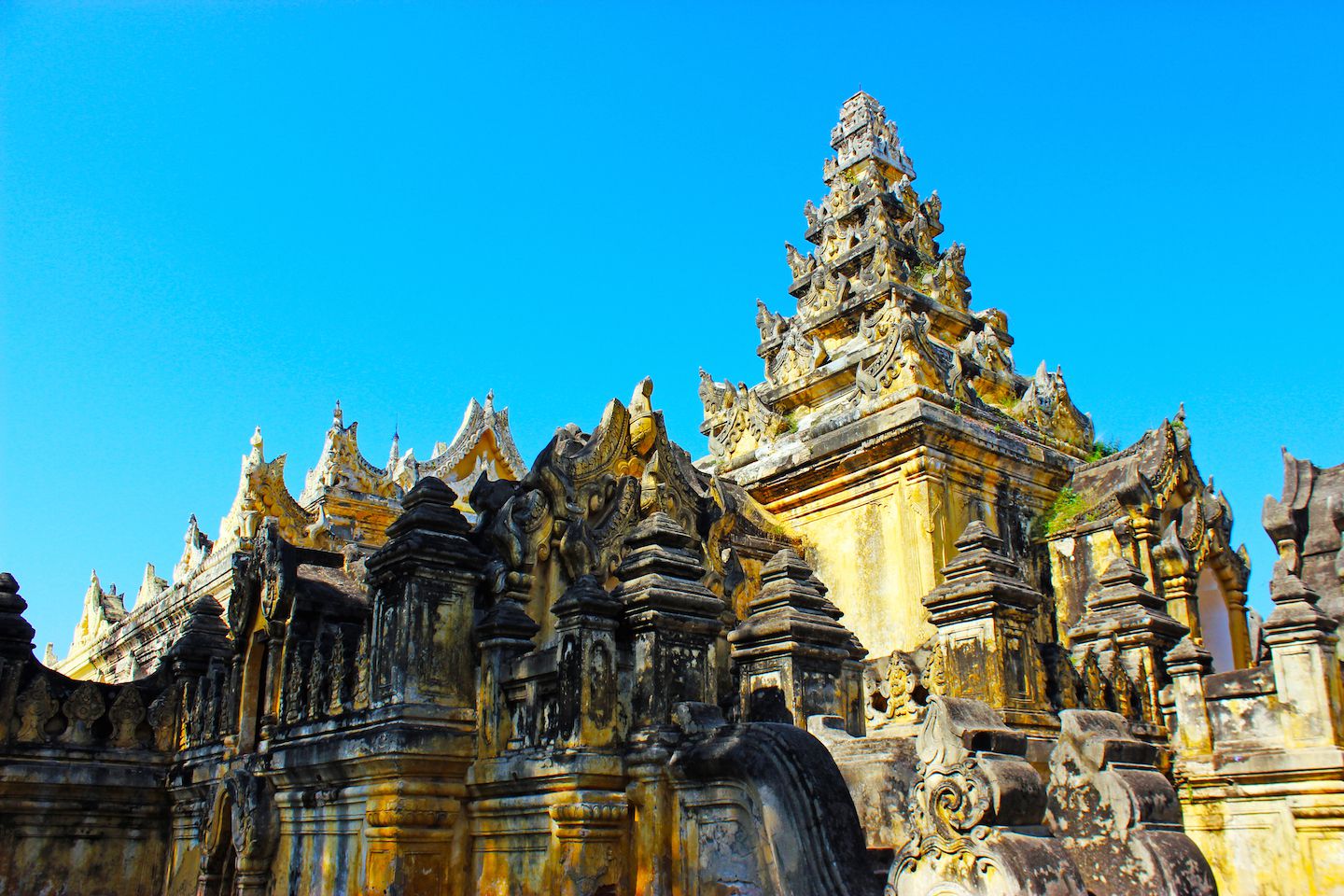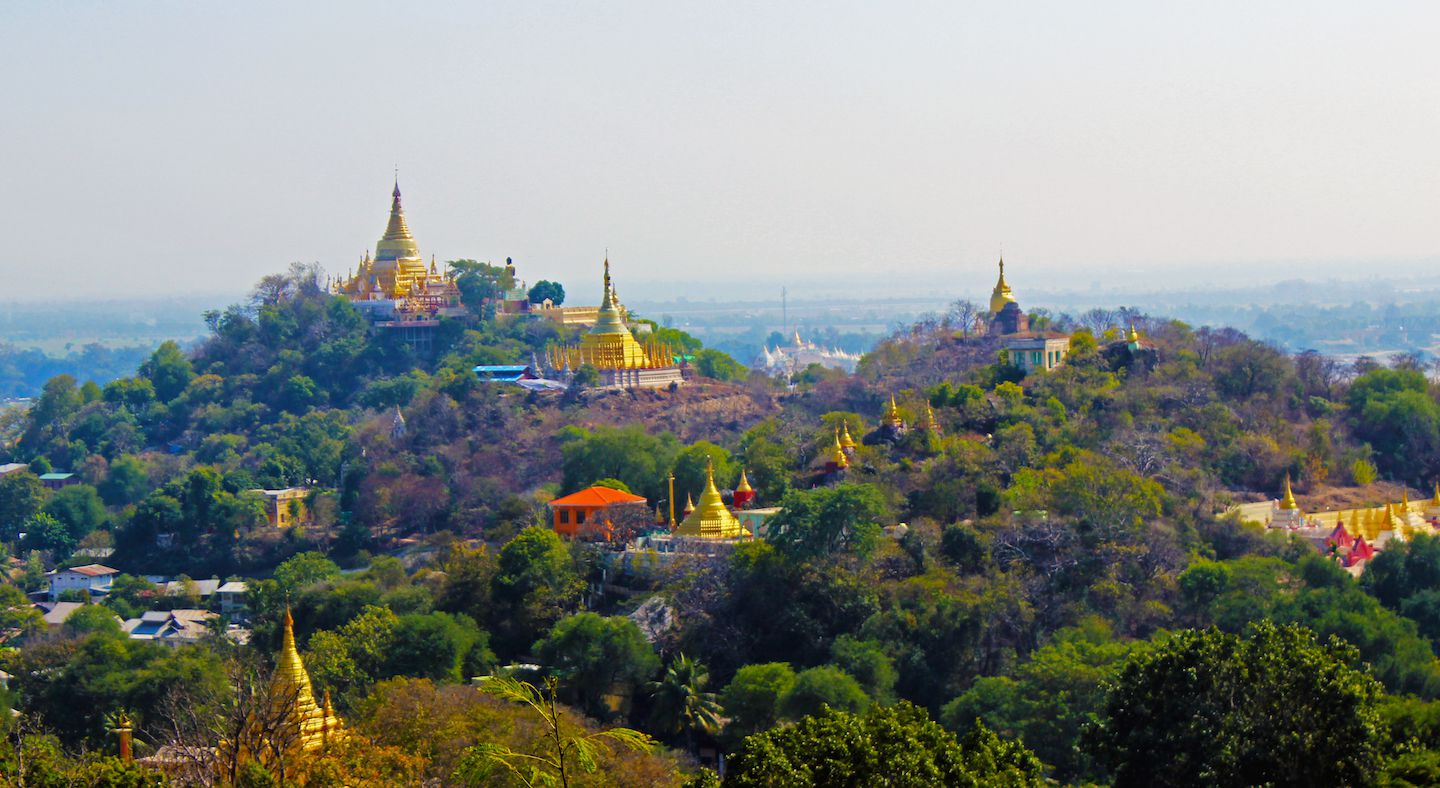The last royal capital of Myanmar, the chaotic and lively city of Mandalay was our destination after the calm and tranquil hill town of Kalaw. After being dropped off at 3am in the city (which has become quite the routine in Myanmar), we found a hotel room to rest and wait for the ungodly hours to pass by. Strolling through the long and dusty roads in the city on the first day, it was easy to see why Mandalay is generally used as a hub for day trips to its surroundings.
In order to better explore the area, we booked a three-city tour with our hotel, which included visits to Amarapura, Inwa and Sagaing, all on the outskirts of Mandalay.
U-Bein Bridge in Amarapura
Immediately south of Mandalay, Amarapura used to boast its title of capital of Myanmar in the old days; however, today it is definitely best known for being home to U-Bein Bridge. The oldest and longest teak wood footbridge in the world, U-Bein Bridge extended itself for 1.2km through the shallow Taungthaman Lake.

Even before this trip started, I’ve heard about U-Bein Bridge and was excited to see it mostly because of its importance to the local community as well as the engineering behind it. The bridge was built using only footsteps as a measure of scale. A half-moon shaped design helped the bridge to stay strong all of these years against water currents and wind gusts. Since 1851, when construction ended, it has served as a major passageway for locals and monks, who carry their goods and trades for the day across the lake every single day.

Even though U-Bein Bridge was one of the most photographed places in Myanmar, crossing the bridge was the real attraction. Parts of the bridge were unstable and shifted from side to side as people walked by. The lack of parapets on the sides and some broken wooden planks beneath our feet added to the whole experience. A funny fact we noticed was that most foreigners walked right in the middle of the bridge, afraid of falling into the lake, whereas locals didn’t really care and walked the path of least resistance.

From the bridge, we had a beautiful view of the entire area. The transition of colors from the dark blue waters of the lake to the vivid green of the crop fields to the light blue of the sky, combined with the bridge vanishing in the distance, all made a beautiful sight. We sat on one of the many benches and gazed at it for a while.

The best view of the bridge is during sunset, but we had a full day ahead of us and moved on to our next stop in Inwa.
Temples and Ruins of Inwa
Just like Amarapura, Inwa had its golden times as the capital of Myanmar. In the present days though, not much is left of the old Kingdom of Ava and the township is a rural backwater with temples and ruins dotting its landscape.
Usually tourists cross over from Amarapura to Inwa by boat and then hop on a horse cart to explore the ruins. After reading many reviews online, we deemed it to be a tourist trap and made sure when we booked our tour that a car would drive us around so we could skip the whole horse cart thing. Of course the message was lost in translation/communication, and on the day of the tour, the driver refused to do so, claiming that the roads on the other side were not in driving conditions for a car. After some arguments and almost abandoning the tour altogether, we convinced our cab driver to honour our agreement and drive us around. As we suspected, the roads in Inwa were absolutely fine and there were a few cars driving by.

The first stop in Inwa was the ancient-looking, teak wood Bagaya Kyaung monastery. Besides the red tiered roof and the wood carved motifs on the walls, the monastery wasn’t particularly wonderful. We stopped for a short visit and moved on to the next attraction. If anything, the jammed line of horse carts packed with tourists arriving to the monastery was much more memorable.

Maha Aungmye Bonzan was a royal monastery and showed the weight of its age on the faded yellow-colored, stucco-covered walls. Besides the pediments and roof decorations on the outside of the building, there wasn’t much inside besides screeching bats.

Last but not least, the old leaning and crumbling tower of Inwa. The deteriorated state of the building made a visit inside the structure at the top impossible – a sign on the stairs stopped tourists and locals from attempting the climb up. Our time in general in Inwa was brief as the ruins were really in ruin, so we headed to Sagaing.

Sagaing Hill
Southwest of Mandalay on the other side of the Ayeyarwady river is Sagaing, a small hilly township with hundreds of monasteries and nunneries. Individually, none of them were particularly interesting attractions; however, all of them together were a beautiful sight, a glimpse into what Bagan would be like later on.
We were dropped off at the base of the 380+ stairs up to Sagaing Hill. The way up wasn’t too bad. Parts of it were certainly pretty steep, but a roof covering the entire way provided protection from the sun so the journey up was bearable. Other stairs branched off the main path that connected with other pagodas and monasteries nearby.

When we arrived at the top, we were rewarded with a splendid view of the dozens of gilded pagodas crowning the green hills of Sagaing. It was quite a panoramic perspective of Sagaing and worth the climb up.

For the last stop of the day, we traded Sagaing Hill for sunset at Mandalay Hill.
Mandalay Hill
Similar to Sagaing Hill, we started off at the base of the southern footsteps of Mandalay Hill. If the ascending journey in Sagaing wasn’t challenging enough for us, the barefoot walk up Mandalay Hill certainly put our legs to work. The path seemed endless. We would reach a landing expecting it to be the top, only to turn and climb another set of stairs. This happened again and again. We finally made it to the top of the 230m hill after almost an hour.

The main draw here was the sunset over the entire city of Mandalay. As it got closer and closer to sunset, the top of Mandalay Hill became more and more crowded with people. Throughout Myanmar, we had not seen nearly as many tourists as other countries. Even within the cities we have visited, fellow tourists were few and far between. Where were they, we wondered? Where were all the foreigners that flew into Myanmar with us? Well, now we found out – they were all here on Mandalay Hill.

The view from the top of Mandalay Hill was definitely unbeatable. There was no better place to see Mandalay and the surrounding area from up above. However, it wasn’t the best panoramic or sunset view that we had ever seen. No extravagant buildings or outstanding lake views – simply a flat concrete city surrounded by green fields and a few mountains in the distance. That being said, the sunset itself did add a pretty gold and orange tone to both the sky and the city. I guess we have seen some extraordinary sunsets that are hard to compare against.

The smaller cities surrounding Mandalay were the crown jewels of our stop here. It was interesting to see how a centenary wooden bridge still has such an important role in the life of locals, or how monks retreat to the hilly temples of the area to pray and worship their divinities. Moreover, it gave us glimpses of what life is like in northern Myanmar, since we won’t be reaching the more northern parts of the country. Next, we head west to Bagan.
For more pictures of Mandalay and surroundings, please visit the gallery!

